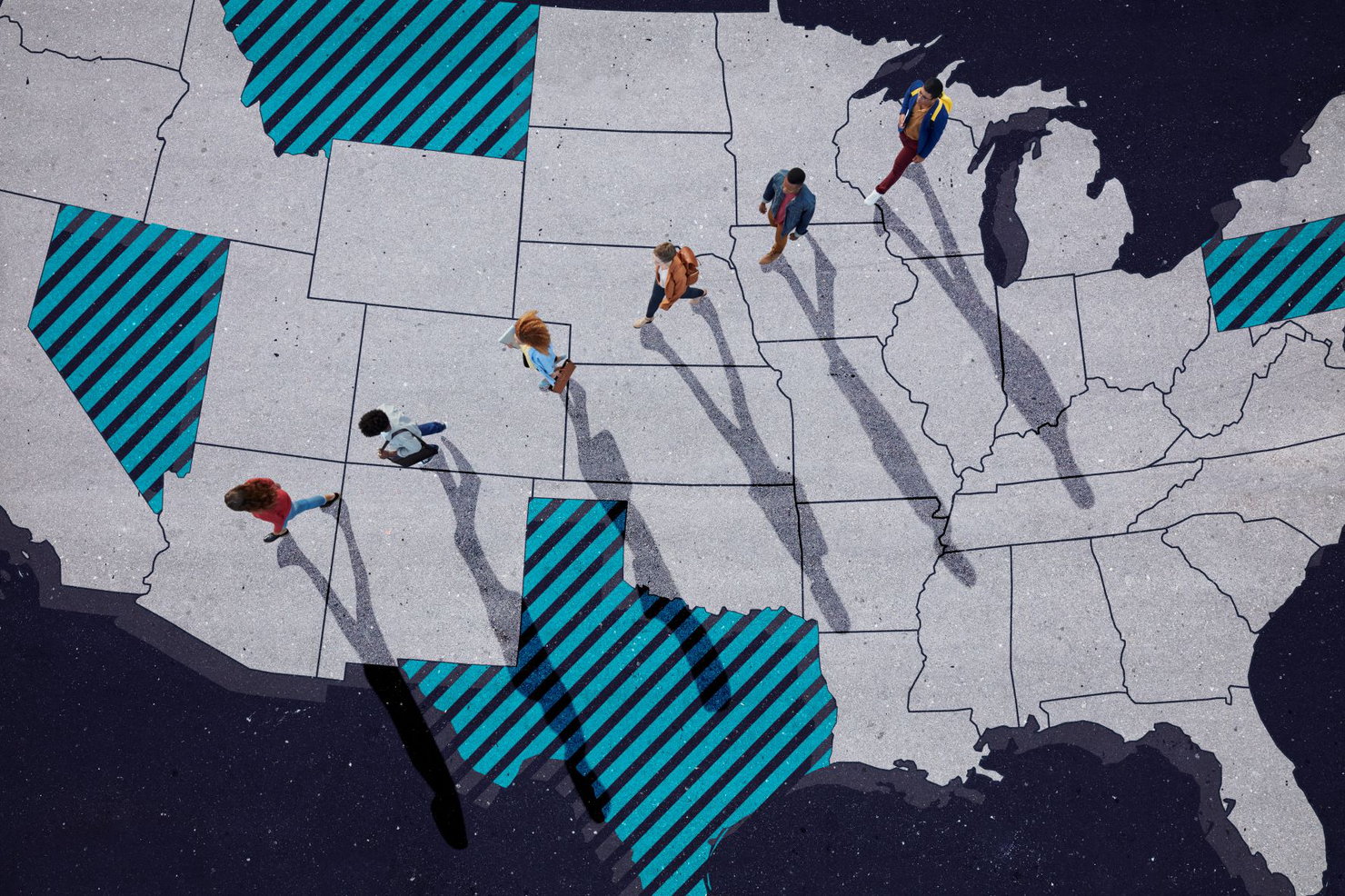Increased levels of individual state action will be important as decarbonization efforts ramp up federally and throughout the United States. Moving forward, Resources for the Future will work with state decisionmakers to support climate goals in areas like energy transmission and distribution planning, resilience and reliability in the electric grid, and emissions in the transportation sector.
Climate change is the single greatest environmental threat of our time, with pervasive economic consequences. Given the presence of greenhouse gas emissions throughout the whole economy, actions are needed at multiple levels of government to facilitate and drive the necessary changes.
At the federal level, a substantial step forward in climate legislation emerged this summer when President Joe Biden signed the Inflation Reduction Act into law. At the same time, some states have been expanding the ambition and breadth of their own efforts. These efforts include policy frameworks such as emissions markets, alongside the development of renewable energy sources, alternative fuels, vehicle efficiency improvements, and electric vehicle markets. States with significant fossil fuel extraction and processing also are grappling with how to transition their economies away from these activities effectively and equitably.
In this legislative landscape, we expect that insights from Resources for the Future (RFF) will be in high demand from state decisionmakers. RFF will engage with these decisionmakers, who push the frontier when federal action lags and yet often wind up at the front lines of implementing federal policies (including actions related to the bipartisan Infrastructure Investment and Jobs Act of 2021 and the Inflation Reduction Act of 2022). State-level policy development consistently has been a test bed and catalyst for additional federal climate action. RFF will provide state-level policymakers the best available information to make smart and equitable decisions that benefit people, health outcomes, and the environment and economy we all depend on.
Our policy engagement with the states falls into two broad categories. First, we help design smart emissions-reduction strategies at the state level. We recognize the complexity of the climate challenge and the clean energy transition. Second, we focus on state implementation of federal action, alongside regional efforts coordinated among the states. Of course, we aim to create comprehensive climate solutions that are equitable and to achieve emissions goals at lower cost to the economy. Accordingly, we intend to integrate environmental justice concerns into all of this work.
Here are examples of what this work will look like in practice.
We will support various state-level efforts toward reaching decarbonization goals.
California currently leads the nation in state-level ambition and policy implementation. We will identify opportunities to reform California’s cap-and-trade program through assessment and modeling, which then can be used for subsequent policy engagement. We’ll plan to explore how cap-and-trade reform in California may affect allowance prices, how auction revenues can support investments granted by the Greenhouse Gas Reduction Fund, which industries may see benefits or negative consequences, and more. This work can be a platform for a broader examination of potential market reforms, such as changes in the annual introduction and value of emissions allowances, changes in the auction price floor, adjustments to the supply schedule for allowances, and reconsideration of the allocation of free allowances to industry.

Other states have been following California’s lead. We will evaluate how emissions-reduction targets in New Mexico and Nevada (both aiming for emissions reductions of 45 percent below 2005 levels by 2030) can be achieved through an economy-wide cap-and-trade program. Washington State already has implemented cap and trade, with the state aiming for emissions reductions of 45 percent by 2030 and 95 percent by midcentury. We’ll evaluate the following three things: the impact on emissions of a cap-and-trade program in concert with existing and anticipated future policies; how an economy-wide cap-and-trade program performs in terms of costs and certainty of emissions-reduction outcomes, relative to a purely sector-by-sector policy approach; and opportunities to drive cost-effective reductions by linking programs across states that have comparable climate policy objectives.
One such program, the Regional Greenhouse Gas Initiative, is growing. Over 10 years ago, nine northeastern states joined together to create a regional cap-and-trade program for the electricity sector. The initiative continues to explore growth opportunities in terms of ambitious emissions targets, expansion to other sectors, and expansion to other states. Through modeling, convening, and informal consultation, we have informed those decisions in the past and will continue to do so in the future.
Finally, much of the burden of the energy transition falls on states and communities with substantial fossil resources that will need to find equitable ways to transition their economies toward a future of net-zero emissions. RFF’s Equity in the Energy Transition Initiative has led the way in both understanding the likely impacts of the transition and exploring opportunities. This work will continue, with additional place-based analysis and, equally importantly, engagement with local communities.
We’ll help state decisionmakers decarbonize the transportation sector.
Along with incentives in the Infrastructure Investment and Jobs Act, the recently passed Inflation Reduction Act helps facilitate decarbonization of the transportation sector in the United States. Related strategies include improving the affordability and accessibility of electric vehicle charging, accelerating investment in public charging stations, and managing the costs of delivering electricity to charging infrastructure. Much of the implementation of these provisions will be carried out by the states. We will work with federal agencies and state governments to help model various options that can maximize the effectiveness of federal spending.
We’ll help figure out ways to enhance the resilience of the electric grid.
The Infrastructure Investment and Jobs Act also directs the US Department of Energy to establish a grant program that helps mitigate impacts to the grid due to extreme weather, wildfires, and natural disasters. The act calls for another program, based on a collaboration of the states with owners and operators in the electricity sector, to create innovative ways of enhancing regional grid resilience through research, development, and demonstration. The Inflation Reduction Act includes funding to help state-siting authorities expedite siting and to facilitate related activities, including transmission studies and stakeholder convening. We’ll assist states in evaluating the options for designing electricity programs and allocating funds, so we can help optimize related decisionmaking and support stakeholder engagement.
We will consider and address the environmental justice implications of climate policies and state initiatives.
While California has been an ambitious leader in climate change mitigation, New York State has led the nation in its own efforts to consider mitigation alongside environmental justice concerns. We’ve been working with the New York City Environmental Justice Alliance and other research partners to help New York State credibly measure the environmental justice implications of climate policies under the state’s Climate Leadership and Community Protection Act. RFF researchers will model different policy options crafted by both the state and the environmental justice community, respecting their different positions and enabling policymakers and others to transparently evaluate the trade-offs involved. Specifically, we’ll be looking at how different greenhouse gas mitigation policies can affect air pollutant emissions and how changes in those pollutants would affect air quality on a hyperlocal scale. This work will allow us to identify the expected impacts on specific disadvantaged communities.
With the New York State Energy Research and Development Authority, we will assess the viability of potential carbon pricing regimes. Policymakers in New York State need to design an administratively functional, effective, and durable carbon pricing policy. To be most effective, the policy needs to limit emissions and the loss of capital to surrounding regions and proactively address the potential adverse effects on disadvantaged communities.

Any potential carbon pricing policy must accommodate other state and regional policy priorities; the composition of the economy, the electricity grid, and transportation needs in New York; and the state’s commitment to economic and racial justice as articulated in the Climate Leadership and Community Protection Act. We will illuminate how carbon pricing has performed in various real-world settings and how a carbon pricing policy can be designed to complement other policies and avoid pitfalls. We’ll concentrate on the role of policy design and policy sequencing in shaping the expectations of New York residents and the business community, and how those variables may contribute to the success of climate policies. Our work in New York could be expanded to other states, too.
Beyond New York, the Inflation Reduction Act includes provisions that states can leverage for environmental justice efforts, which RFF scholars will be tracking in the near future. For example, the law allocates $3 billion for a new environmental and climate justice block grant program for community-led pollution monitoring, prevention, and remediation, alongside investments in low- and zero-emissions technologies. The funding also will support workforce development, risk mitigation for extreme heat and wildfires, climate resilience and adaptation, the reduction of indoor toxins and air pollution, and procedural justice for disadvantaged communities at the state and federal levels. Further provisions of the law are related to energy and reductions in greenhouse gas emissions; for example, special incentives and additional funding are available for disadvantaged or underserved communities.
Federal funding alone can go only so far in addressing environmental justice concerns. Many problems can be addressed only at the state and local levels. For example, states handle permits for industrial facilities, and environmental justice communities have concerns about the cumulative environmental impacts from such facilities. A landmark New Jersey law, adopted in 2020, addresses these types of issues, with a similar bill passed recently in New York. And states often can determine how they spend funding received from the federal government—though this discretion does not always benefit environmental justice communities.
Getting to a Net-Zero Resilient Economy by Informing US State Climate Policies
RFF researchers have generated critical policy studies that have been used in the crafting of every major piece of energy and environmental legislation and policy that’s been signed into law over the past 70 years. We’ll be there to offer states this same expertise as critical new elements of policy start addressing inequities and environmental justice, and as energy and environmental policy efforts evolve.






